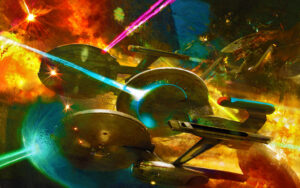
As the gamemaster for a Star Trek Adventures roleplaying game, it’s important to recognize the different styles the players gravitate toward. Then, it’s your job to create plots and subplots that appeal to the majority of your group at a time and to work in elements to please the other players throughout the course of a session.
 I have a player named Alan who is an Enterprising player. The Captain can’t finish a request before he volunteers his character’s specialties. Other players may be better equipped to handle the skill test, but Alan is there volunteering to assist on the roll, using in-character reasons why this is a good idea.
I have a player named Alan who is an Enterprising player. The Captain can’t finish a request before he volunteers his character’s specialties. Other players may be better equipped to handle the skill test, but Alan is there volunteering to assist on the roll, using in-character reasons why this is a good idea.
You want to have Enterprising players at your table. They keep the action moving forward. However, they tend to hog the spotlight and have to be reminded that the other players are there to participate also.
Jeremiah is an Intelligence Gathering player. You might think he’s not paying attention or feels left out being the CMO, when there isn’t a medical emergency on the ship. He analyzes everything that’s going on and is always trying to put the pieces together. He’s the type of player that will catch the clues you try to sneak pass the other players… and they often miss the details as they’re engrossed in conversation about how to face the other challenges you’ve described.
Players who gravitate toward Intelligence Gathering tend to like personal story lines that challenge their values. That’s why I had Jeremiah’s character, a Klingon, face the struggle of coming to terms as a Federation officer tasked to aid in an attack on the Klingon Empire during the time the Klingons backed out of the Khitomer Accords.
Then there’s the Entertaining character. When I think of my own group, I don’t see a clear-cut example of this type. The closest I have is Wes, who is quick to interact with an NPC, setting things up for a comedic exchange. It’s important to provide for these players by offering them light-hearted moments to break away from the serious “saving the galaxy” feel of the game. By offering these players a chance to make the group laugh, these players will know you’re taking their needs into consideration.
An important thing to note about Entertaining players is the rest of the group needs to feel safe. They shouldn’t feel triggered by interactions with the antics of an Entertaining player and laugh along with the character instead of feel they’ve been mentally assaulted.
For the Defending type of play style I’m again reminded of Alan. He’ll bargain for every point of Endurance his character or the ship loses. He’ll push for every bit of power that can be routed into the shields. He’s quick to point out when I make a call that’s contrary to what’s in the printed book.
Players who act this way are often concerned for the “life” of their character and don’t want to see them die or fail at a mission. They hold the whole group up to high standards to join him in the quest of keeping everyone alive and succeeding.
Gamemasters can cater to these players by having fair encounters. I’m not a good example of this because I believe players should tell when they’re outmatched and run, something I picked up from Deadlands. But, if the player sees the combats are challenging but fair, they’ll feel safe about taking risks and trusting the gamemaster to not carelessly lead the group into a TPK.
Then, there’s the Protocoling player. I have a player who roleplays the Section 31 agent and Security Officer Aneia. She suffered a nasty injury that destroyed her spine. Living in a specially engineered suit she’s tougher than ever and is massively armored. She has Shadowrun type technology built into her suit and takes over any combat with her sword. Aneia was built to maximize her usefulness, finding devices and technology to give her an edge at the tasks she specializes in.
The smart thing to do for these players is to let them excel where they excel. If Aneia is like River Song in melee combat, throw armies of troops at her to cut down. Also, arrange for her to have to undertake tasks where her skills aren’t maxed out. If Aneia is the only one conscious on the Bridge who can pilot the ship out of the plummet into a planet’s gravity well, her character will find a way to save everyone’s lives, even though she doesn’t have all the modifiers already in her favor.
Finally, we get to the Tactical player. This person wants a starship battle in every session. At my table my group is pretty good at running away from overwhelming threats. I don’t have a player calculating how their ship can overcome a Borg Cube.
But for gamemasters who have players like this, find ways for the group to be involved in space combat. There are plenty of exciting examples of space combat in the Star Trek sagas. Also, when on away missions, have packs of predators attack the group, or have the lost space station be guarded by robotic armies. That will give the Tactical player a thrill.
These are the main play styles of Star Trek Adventures players, as described by the Star Trek Adventures Gamemasters Guide. When designing your sessions, be sure to address the needs of as many of these players as possible. As for the rest, don’t go too long without catering to their playstyles. You’ll have a group that won’t want your sessions to ever come to an end.
